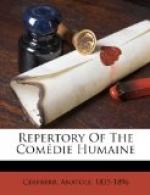BRIDAU (Joseph), painter; younger brother of Philippe Bridau; born in 1799. He studied with Gros, and made his first exhibit at the Salon of 1823. He received great stimulus from his fellow-members of the “Cenacle,” in rue Quatre-Vents, also from his master, from Gerard and from Mlle. des Touches. Moreover he was a hard-worker and an artist of genius. He was decorated in 1827, and about 1839, through the interest of the Comte de Serizy, for whose home he had formerly done some work, he married the only daughter of a retired farmer, now a millionaire. On the death of his brother Philippe, he inherited his house in rue de Berlin, his estate of Brambourg, and his title of comte. [A Bachelor’s Establishment. A Distinguished Provincial at Paris. A Start in Life.] Joseph Bridau made some vignettes for the works of Canalis. [Modeste Mignon.] He was intimate with Hippolyte Schinner, whom he had known at Gros’ studio. [The Purse.] Shortly after 1830, he was present at an “at home” at Mlle. des Touches, when Henri de Marsay told about his first love affair. [Another Study of Woman.] In 1832 he rushed in to see Pierre Grassou, borrowed five hundred francs of him, and told him to “cater to his talent” and even to plunge into literature since he was nothing more than a poor painter. At this same time, Joseph Bridau painted the dining-hall in the D’Arthez chateau. [Pierre Grassou.] He was a friend of Marie Gaston, and was attendant at his marriage with Louise de Chaulieu, widow of Macumer, in 1833. [Letters of Two Brides.] He also assisted at the wedding of Steinbock with Hortense Hulot, and in 1838, at the instigation of Stidmann, clubbed in with Leon de Lora to raise four thousand francs for the Pole, who was imprisoned for debt. He had made the portrait of Josepha Mirah. [Cousin Betty.] In 1839, at Mme. Montcornet’s, Joseph Bridau praised the talent and character displayed by Dorlange, the sculptor. [The Member for Arcis.]
BRIDAU (Flore Brazier, Madame Philippe), born in 1787 at Vatan Indre, known as “La Rabouilleuse,” on account of her uncle having put her to work, when a child, at stirring up (to “rabouiller”) the streamlets, so that he might find crayfishes. She was noticed on account of her great beauty by Dr. Rouget of Issoudun, and taken to his home in 1799. Jean-Jacques Rouget, the doctor’s son become much enamored of her, but obtained favor only through his money. On her part she was smitten with Maxence Gilet, whom she entertained in the house of the old bachelor at the latter’s expense. But everything was changed by the arrival of Philippe Bridau at Issoudun. Gilet was killed in a duel, and Rouget married La Rabouilleuse in 1823. Left a widow soon after, she married the soldier. She died in Paris in 1828, abandoned by her husband, in the greatest distress, a prey to innumerable terrible complaints, the products of the dissolute life into which Philippe Bridau had designedly thrown her. She dwelt then on rue du Houssay, on the fifth floor. She left here for the Dubois Hospital in Faubourg Saint-Denis. [A Bachelor’s Establishment.]




